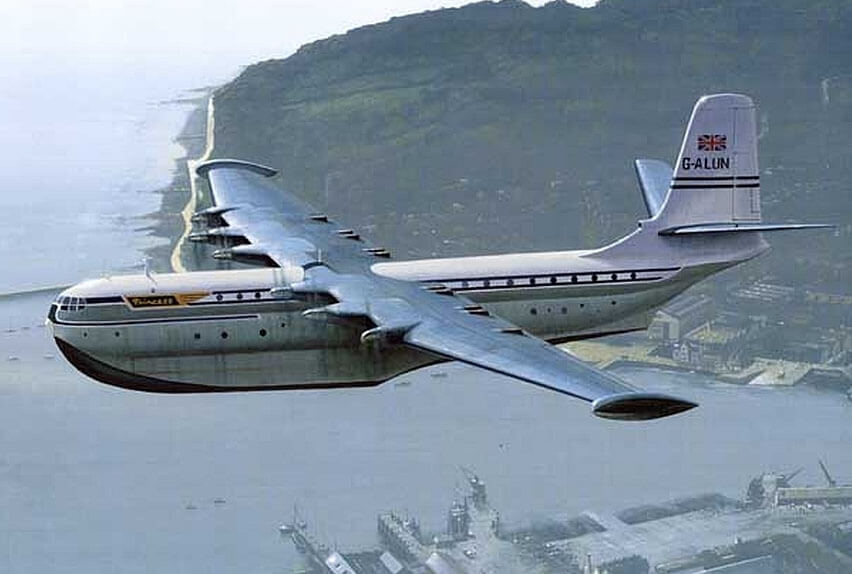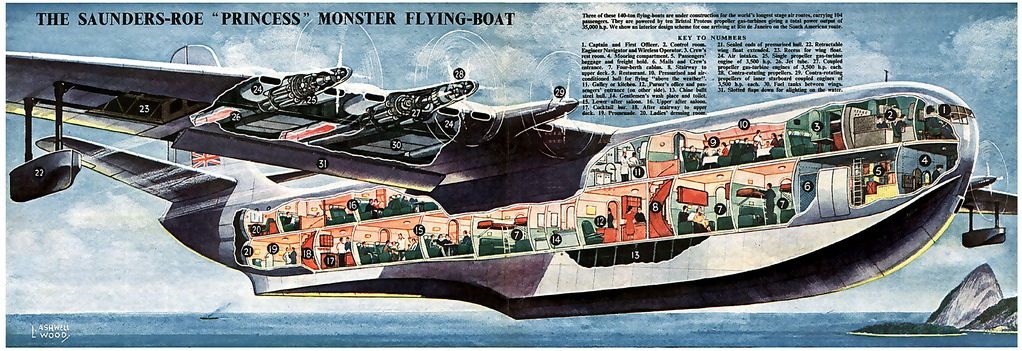The Saunders-Roe Princess was the last large flying boat produced in the world. First flying on 22 August 1952, it featured two decks, capable of carrying 105 passengers on intercontinental flights.
Powered by six Bristol Proteus turboprop engines, it featured a range of 9,210 kilometres and cruised at a 580 kilometres per hour. Just one aircraft took to the sky, as the flying boat era was essentially already finished when it was produced.
Saunders-Roe Princess Video
Following on from the last video about the Boeing 737-100, this time we cross the Atlantic and look at the Saunders-Roe Princess flying boat. The video is produced by the excellent Mustard channel on YouTube and runs for around 10 minutes.
Lush animation is a hallmark of the videos produced by Mustard, and this one continues the trend. All aspects of the Princess are covered, such as the details of its design, the reasoning behind making the aircraft and why it was not a success.
Saunders-Roe Princess Interior
The aircraft was designed for luxury travel and featured two complete decks. Passengers would have had access to an on board lounge, dressing rooms and even single and twin berth cabins.
Overall Thoughts
The Saunders-Roe Princess is another one of those interesting British designs that never entered service. While their aviation industry was technologically advanced, some of the designs from that era were very ill timed.
Did you know about this flying boat? What did you think of the video? Thank you for reading and if you have any comments or questions, please leave them below.
Enjoying the series? Check out the index to all the “Does Anyone Remember…” articles.
To never miss a post, follow me on Facebook, Twitter and Instagram.
All my flight and lounge reviews are indexed here so check them out!
Featured image via Flight Manuals Online.
Cutaway via Pinterest.
Seating plan via Simanaitis Says.















For many years, “the boats,” standing on their beaching gear were stored “cocooned” and parked in the open, exposed to the marine environment on the waterside hardstandings at Calshot Spit (the former RAF flying boat base at the south-western corner of Southampton Water and looking south across the Solent towards Cowes, where they were manufactured by Saunders-Roe (Saro)).
Eventually, the boats where towed north, up Southampton Water, passed the former Imperial Airways flying boat base at Hythe, then up the River Itchen, to their last resting point.
As I child, I sadly remember that my wonderful father took me to the beach at Hamble (on the east bank of Southampton Water, adjacent to the former A.V. Roe (Avro) aircraft factory) to watch the proceedings and salute the aircraft as they passed-by.
We then drove to the former Supermarine aircraft works, at Woolston, where the boats were beached, to be heartlessly dismantled, scrapped and disposed of over their last few months.
After a life-time in aviation, I can still see those magnificent giant aircraft in my mind’s eye and, even today, it still makes me feel so very sad! An aircraft was not left for the future.
I enjoyed reading that, it’s nice to know the fate from someone who was there. You are right, it is a real shame that none of them exist today. Thanks very much for that!
Lovely reminiscences from your childhood of an adventure with your Dad.
I’d love the opportunity to see one in a museum, along with the Brabazon but I guess the powers that be thought otherwise.
I saw the prncess seaplane in the early 50s passing over oswestry flying from east to west on a beautiful summers day, went outside on hearing a plane engine,looked to the east and saw this huge plane coming towards us, it was clearly struggling to stay in the air as the fuselage was bobbing up and down with wings flexing thought they where going to break off,it must have been a good twenty minutes before it finally disappeared from our view heading west,anyone know where it was heading we thought it was likely to fall out of the sky.
Must have been something interesting to see, that’s for sure! Amazing how they thought it a good idea to build a prototype flying boat when it was clearly already obsolete technology. I remember a quote from a flying boat Captain who said it was great they were gone because they were so dangerous to take-off and land compared to land planes. I thought that interesting!
When G-ALUN was eventually sold for scrap in the late ’60’s, I was involved with towing it into the scrapyard at Woolston. G-ALUN had been towed into Southampton by the ex-TID tug Dagger. We took over the towage into the shallow waters of the scrapyard. I have several (poor quality) photos taken by an onlooker, showing us assisting with her final movements.
Pretty cool that you had a hand in the story. Must have been an interesting experience all round. Thanks for sharing that!
I was about fifteen at the time with my dad in our boat just off of Cowes on the Isle of Wight and witnessed the Princess flying boats first take off, she looked pretty cumbersome and seem to struggle but suddenly lifted and was away, it was an amazing spectacle but shortly after she was pulled up on a concrete hard on the West Cowes side cocooned and sat there for a few years.
Not many people about who would have witnessed that. I bet that was a very memorable experience, especially with such a large aircraft. A shame the flying boat era was over already by that time. It would have been wonderful to see such a thing in flight, not to mention to fly on board. Thanks for the comment!
Ten Bristol Proteus turboprop engines. On each wing, the inner 2 propellors were each powered by 2 of the engines per propset, with the outer engine just having a single powerplant.
Quite a lot of power, isn’t it? I can’t imagine it was particularly quiet either!
I grew up in East Cowes, Isle of Wight, where the Princess was built. I didn’t see her maiden flight as I was only five years old. However, I saw dozens id]f her later test flights, which continued for a couple of years. One day, probably because of wind conditions, she took off from the Solent and headed across town, flying right over our playground and hardly clearing the trees behind us.
Sadly, just as the Proteus engines reached the power needed to make the Princess viable, the De Havilland and other jet aircraft had rendered prop-driven Atlantic aircraft obsolete. The three Princesses were mothballed, with two stored on the shore Southampton Water and one across the river from the Saunders Roe factory. I remember an impromptu Christmas party inside of her just before it was mothballed.
There were rumors in 1964 that an American wanted to buy them all to transport Saturn rocket subassemblies across the US but they had deteriorated badly and the plans fell through. Sadly, none of them made it to a museum and they had all been broken up by 1967.
Footnote: Saunders Roe built a few more noteworthy aircraft, plus the Black Knight and Black Arrow rockets, before turning to helicopters and building the first seagoing hovercraft. I saw the maiden flight of the first, the SRN-1. Many of the SRN-6 model are still in service. One of the largest ones, an SRN-6, ferried cars and passengers across the English Channel for years and is now in the Hovercraft Museum.
What a great memory, having something that large fly right over you so closely! Lucky it made it, from the sounds of things. It is a shame that the passenger flying boat era essentially ended, as I would have really liked to have flown on board something like that. I wasn’t aware of the Saturn story, so that’s interesting and not surprising considering the aircraft size. Thanks for the all the information – a hovercraft is another mode of transport I have yet to experience. I think the 1950s and 1960s were a fascinating era for all the various inventions, companies and so on when it comes to transport. Thanks very much for the comment!
from what I saw from the ground of the flying ability of the princess I doubt very much that the aircrew could have been wishing they where not in it while it was in the air and dreading what would happen when it was time to land.
It certainly looked quite ungainly in the air from the photos and what not that I have seen. I doubt it would have too much maneuverability.